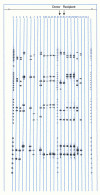Glomerulonephritis after hematopoietic cell transplantation: IgA nephropathy with increased excretion of galactose-deficient IgA1
- PMID: 20067905
- PMCID: PMC2910332
- DOI: 10.1093/ndt/gfp693
Glomerulonephritis after hematopoietic cell transplantation: IgA nephropathy with increased excretion of galactose-deficient IgA1
Abstract
We report the development of IgA nephropathy (IgAN) following full myeloablative allogeneic hematopoietic cell transplantation in two patients with human leukocyte antigen (HLA) matched sibling donors, unrelated to active or chronic graft-versus-host disease. Both recipients had elevated urinary levels of galactose-deficient IgA1, and one donor-recipient pair had elevated serum levels of galactose-deficient IgA1. We propose that IgAN developed after bone marrow transplantation due to a non-graft-versus-host-disease-related multi-hit process associated with glomerular deposition of galactose-deficient IgA1. These two cases provide unique insight into the kinetics of overproduction of galactose-deficient IgA1 and its glomerular deposition and consequential renal injury in IgAN.
Figures



Similar articles
-
Glomerular galactose-deficient IgA1 expression analysis in pediatric patients with glomerular diseases.Sci Rep. 2020 Aug 20;10(1):14026. doi: 10.1038/s41598-020-71101-y. Sci Rep. 2020. PMID: 32820208 Free PMC article.
-
IgA nephropathy and IgA vasculitis with nephritis have a shared feature involving galactose-deficient IgA1-oriented pathogenesis.Kidney Int. 2018 Mar;93(3):700-705. doi: 10.1016/j.kint.2017.10.019. Epub 2018 Jan 10. Kidney Int. 2018. PMID: 29329643
-
Immunostaining of galactose-deficient IgA1 by KM55 is not specific for immunoglobulin A nephropathy.Clin Immunol. 2020 Aug;217:108483. doi: 10.1016/j.clim.2020.108483. Epub 2020 May 30. Clin Immunol. 2020. PMID: 32479989
-
Biomarkers for IgA nephropathy on the basis of multi-hit pathogenesis.Clin Exp Nephrol. 2019 Jan;23(1):26-31. doi: 10.1007/s10157-018-1582-2. Epub 2018 May 8. Clin Exp Nephrol. 2019. PMID: 29740706 Free PMC article. Review.
-
Glycosylation of IgA1 and pathogenesis of IgA nephropathy.Semin Immunopathol. 2012 May;34(3):365-82. doi: 10.1007/s00281-012-0306-z. Epub 2012 Mar 21. Semin Immunopathol. 2012. PMID: 22434325 Review.
Cited by
-
Aberrantly Glycosylated IgA1 in IgA Nephropathy: What We Know and What We Don't Know.J Clin Med. 2021 Aug 5;10(16):3467. doi: 10.3390/jcm10163467. J Clin Med. 2021. PMID: 34441764 Free PMC article. Review.
-
Sequential therapy with cyclophosphamide and mycophenolic acid in patients with progressive immunoglobulin A nephropathy: a long-term follow-up.Clin Exp Immunol. 2016 Feb;183(2):307-16. doi: 10.1111/cei.12719. Epub 2015 Nov 26. Clin Exp Immunol. 2016. PMID: 26439797 Free PMC article.
-
Changes in nephritogenic serum galactose-deficient IgA1 in IgA nephropathy following tonsillectomy and steroid therapy.PLoS One. 2014 Feb 21;9(2):e89707. doi: 10.1371/journal.pone.0089707. eCollection 2014. PLoS One. 2014. PMID: 24586974 Free PMC article.
-
Renal pathology in hematopoietic cell transplant recipients: a contemporary biopsy, nephrectomy, and autopsy series.Mod Pathol. 2016 Jun;29(6):637-52. doi: 10.1038/modpathol.2016.61. Epub 2016 Mar 25. Mod Pathol. 2016. PMID: 27015134
-
Mini-review of kidney disease following hematopoietic stem cell transplant .Clin Nephrol. 2018 Jun;89(6):389-402. doi: 10.5414/CN109276. Clin Nephrol. 2018. PMID: 29578399 Free PMC article. Review.
References
-
- Hingorani S. Chronic kidney disease in long-term survivors of hematopoietic cell transplantation: epidemiology, pathogenesis, and treatment. J Am Soc Nephrol. 2006;17:1995–2005. - PubMed
-
- Brukamp K, Doyle AM, Bloom RD, et al. Nephrotic syndrome after hematopoietic cell transplantation: do glomerular lesions represent renal graft-versus-host disease? Clin J Am Soc Nephrol. 2006;1:685–694. - PubMed
-
- Kimura S, Horie A, Hiki Y, et al. Nephrotic syndrome with crescent formation and massive IgA deposition following allogeneic bone marrow transplantation for natural killer cell leukemia/lymphoma. Blood. 2003;101:4219–4221. - PubMed
-
- Chan GS, Lam MF, Au WY, et al. IgA nephropathy complicating graft-versus-host disease, another nephropathy causing nephrotic syndrome after bone marrow transplantation. Histopathology. 2004;45:648–651. - PubMed
-
- Moldoveanu Z, Wyatt R, Lee J, et al. Patients with IgA nephropathy have increased serum galactose-deficient IgA1 levels. Kidney Int. 2007;71:1148–1154. - PubMed
Publication types
MeSH terms
Substances
Grants and funding
- DK082753/DK/NIDDK NIH HHS/United States
- R21 DK075868/DK/NIDDK NIH HHS/United States
- DK080301/DK/NIDDK NIH HHS/United States
- DK077279/DK/NIDDK NIH HHS/United States
- R21 DK080301/DK/NIDDK NIH HHS/United States
- R01 DK078244/DK/NIDDK NIH HHS/United States
- DK071802/DK/NIDDK NIH HHS/United States
- R01 DK071802/DK/NIDDK NIH HHS/United States
- R01 DK082753/DK/NIDDK NIH HHS/United States
- DK078244/DK/NIDDK NIH HHS/United States
- DK075868/DK/NIDDK NIH HHS/United States
- R56 DK078244/DK/NIDDK NIH HHS/United States
- R21 DK077279/DK/NIDDK NIH HHS/United States
LinkOut - more resources
Full Text Sources
Research Materials
Miscellaneous

